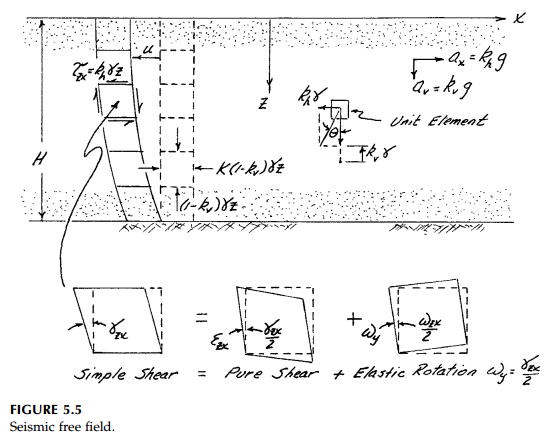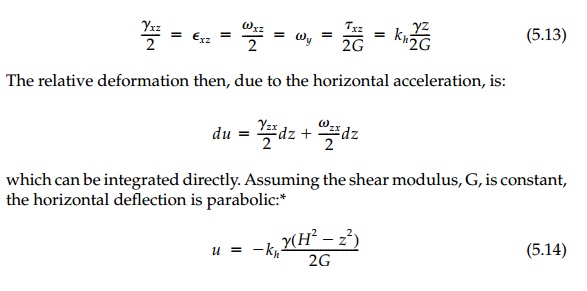Chapter: Civil : Principles of Solid Mechanics : Linear Free Fields
Uniform Acceleration of the Half space
Uniform
Acceleration of the Half-space
With a horizontal
component of body force, the behavior of the half-space is quite different.
Although such body forces may arise in many ways (seepage being a common source
in soils), acceleration, as for example in an earth-quake, is probably the most
important.
Consider the half-space of finite depth H of
material with unit weight γ. From the previous
section, the geostatic field is:


If uniform horizontal* and vertical accelerations, ax
and az, are now applied to the layer as in Figure 5.5, and
the two-dimensional differential equations of equilibrium become:

and the field can be thought of as “one-dimensional plane strain“ (i.e., σ x = σ y and nothing can be a function of x or y). Thus, with the free-surface boundary condition at z =0, Equations (5.10) can be integrated directly to give the solution:

Essentially this dynamic (actually pseudostatic)
solution for the free field is the geostatic free field with a unit weight of
(1 �' kv)γ superimposed with
shear

introduced by the horizontal acceleration component.
However, considering the deformation, this is not “pure shear,“ but a case of
“simple shear“ since there must be an elastic rotation field that keeps
horizontal planes from rotating. From Equation (4.13) or by inspection

This simple result is remarkable. Both the geometric
field condition Ex
=
Ey
=
0 (nothing is a function of x or y) and the equilibrium equations
hold no matter what the distribution of acceleration or material properties.
There is really no restriction on the distribution of kh with
depth, and assuming it constant is for convenience, not necessity. Moreover,
the equations and their solution for the stress field must apply throughout the
acceleration pulse past yield in the plas-tic range to eventual failure, which
can only occur by base sliding. This exact solution does require that, if there
are finite lateral boundaries, then the bound-ary traction on them and their
displacement be distributed as the field equa-tions dictate. However, by St.
Venant’s principle, perturbations to the free field will be insignificant away
from the lateral boundaries as long as the resultant lateral force is
equivalent. We will return to the seismic postyield behavior in later chapters
on plasticity and limit analysis.
Related Topics